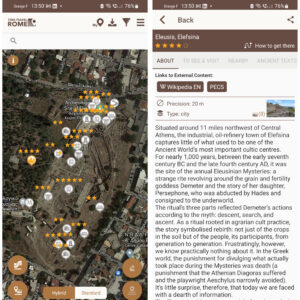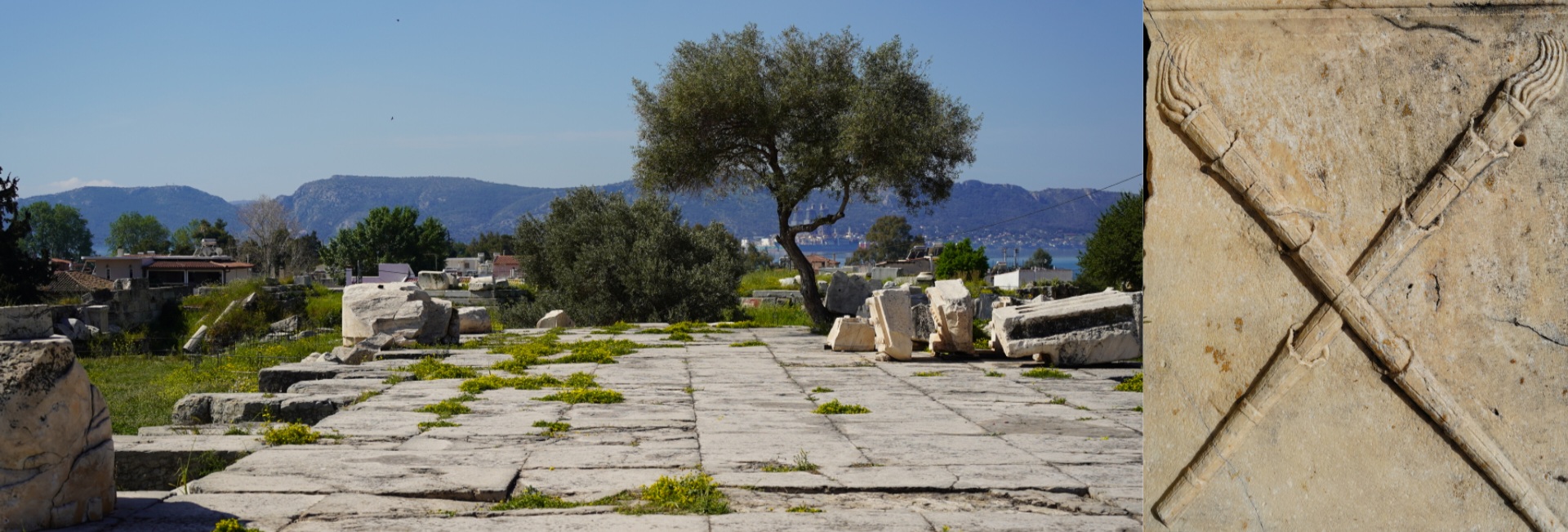Situated around 11 miles northwest of Central Athens, the industrial, oil-refinery town of Elefsina captures little of what used to be one of the Ancient World’s most important cultic centers. For nearly 1,000 years, between the early seventh century BC and the late fourth century AD, it was the site of the annual Eleusinian Mysteries: a strange rite revolving around the grain and fertility goddess Demeter and the story of her daughter, Persephone, who was abducted by Hades and consigned to the underworld.
Eulesian Mysteries
The ritual’s three parts reflected Demeter’s actions according to the myth: descent, search, and ascent. As a ritual rooted in agrarian cult practice, the story symbolised rebirth: not just of the crops in the soil but of the people, its participants, from generation to generation.
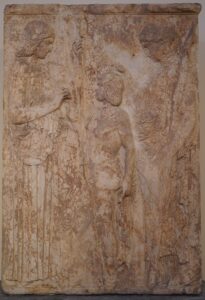
Votive relief in Pentelic marble representing Demeter, Persephone and Triptolemos found in Eleusis 440-430 BC. Source: TimeTravelRome. Dedicated to the sanctuary of Demeter and Kore at Eleusis, it represents a scene from the mystery ritual. At left Demeter holding a scepter offers ears of wheat to Triptolemos, son of the Eleusian king Keleos, to bestow on mankind. At right Persephone, holding a torch, blesses Triptolemos with her right hand. This relief was famous in antiquity and copied in Roman times.
Frustratingly, however, we know practically nothing about it. In the Greek world, the punishment for divulging what actually took place during the Mysteries was death (a punishment that the Athenian Diagoras suffered and the playwright Aeschylus narrowly avoided). It’s little surprise, therefore, that today we are faced with a dearth of information.
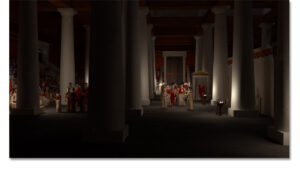
Reconstructed interior of the Telesterion with brazier and torch lights in procession. Source: Anasynthesis.
Despite the fact that we have no written testimonies on the mysteries, the monuments of ancient Eleusis – described below – allow us to reconstruct several key elements of the ancient rite.
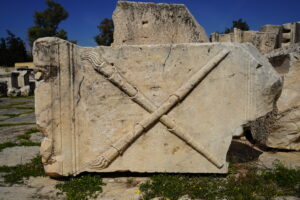
The Eleusinian Mysteries certainly found popularity among the Romans. Several emperors were initiated into the cult (the last one being Julian, the final pagan emperor). Several buildings and constructions – some of which are still visible today – were built by the Roman Emperors, who profoundly reorganized the territory of the Eleusis sanctuary.
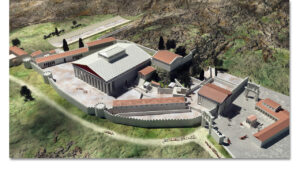
Anasynthesis – 3D reconstruction of the Eulesis Sanctuary. Source: Anasynthesis.
But as Christianity permeated the empire as the dominant religion, less attention was given to Eleusian Mysteries. Eventually in 392 AD the Mysteries were banned by official decree issued by the Emperor Theodosius.
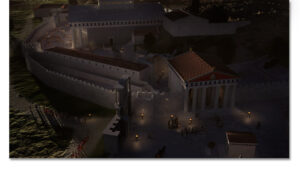
The sanctuary in the 2nd century AD. Torchlight procession to the Telesterion. Source: Anasynthesis.
Eleusis Telesterion
As part of the nine-day festival of Eleusinia, during the month of Boedromion, the Telesterion (or Initiation Hall) was the focal point of the Eleusinian Mysteries. Following the re-enactment of the Homeric Hymn of Demeter and Persephone, the sacred relics of Demeter were revealed to the initiates within the hall. During the ceremonies, the initiates stood on tiers of eight steps arrayed around each side of the naos.
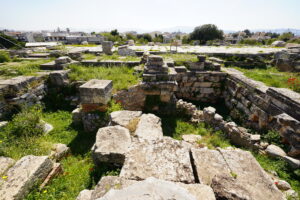
Archaeological Site of Eleusis – Telesterion. Source: TimeTravelRome.
The earliest cult building on the site of the Telesterion was the Anaktoron of the 7th century BC. During excavations at the site, archaeologists found a series of five pits related to the earliest use of the cult building below the porch area of the Telesterion. The pits were built of poros stone and were dug down to the bedrock. They contained animal bones and were likely the megara into which piglets were thrown during the early rites of the Thesmophoria – the religious festival, held in honor of the goddess Demeter and her daughter Persephone.
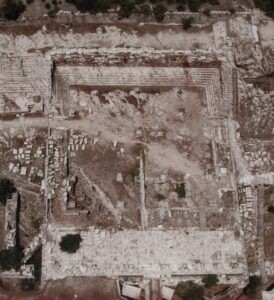
Archaeological Site of Eleusis – Telesterion. Aerial view. Source: TimeTravelRome.
The early cult building was enlarged by Solon, and then later by Peisistratus. Each new building was constructed around the previous sacred site without demolishing the earlier buildings. The Peisistratean-era poros stone Telesterion measured 25x 27 meters with a columned porch on the eastern side and decorative Parian marble cornice. In 480 BC, the Telesterion was destroyed by the Persians and reconstruction started under Kimon.
The Classical Telesterion was designed in the mid-5th century BC under Pericles by the architect, Iktinos, who also designed the Athenian Parthenon. It was built as an almost-square naos with 20 columns supporting a roof with an open oculus at the center. A portico with twelve Doric columns was added around 318 BC.
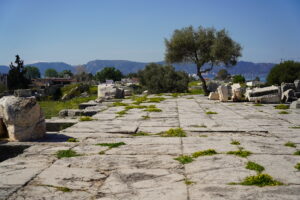
Archaeological Site of Eleusis – Telesterion. Source: TimeTravelRome.
In AD 170, Roman Emperor Marcus Aurelius, rebuilt the Telesterion again after damage by an invading local tribe. The hall was enlarged once more to measure 51 x 53 meters, with a capacity of 2,000 people. This large, 2nd century gathering hall had 42 columns arranged in a regularly spaced rectangle of seven rows of six columns. Following Iktinos’s design, the columns supported an open roof over the naos. Decorative elements were completed in Pentelic marble. A niche displaying the throne of the Hierophant was located in the northeast corner. At this time, the rock-cut seats around the naos were faced with marble.
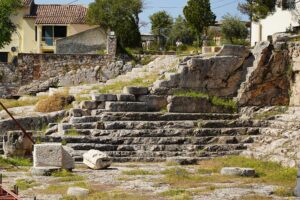
Archaeological Site of Eleusis – Telesterion – seats cut in rock for initiates. Source: TimeTravelRome.
After the Eleusinian Mysteries were banned in the late 4th century AD, the Telesterion was destroyed by the Visigoths and never rebuilt.
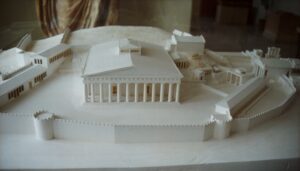
Telesterion and Sacred area in Roman times. By Zde – Own work, CC BY-SA 4.0.
Kallichoron Well
Located alongside the Greater Propylaea at the entrance to the Sanctuary, the Kallichoron Well (the sacred well) was among the most sacred areas related to the festival of Eleusis. According to legend, Demeter rested alongside a well when she first arrived at Eleusis looking for Persephone. The Eleusian women danced around the well in honour of the goddess. While the archaic well referred to in the myth is thought to be the Well of the Maidens alongside the Telesterion, from the 6th century, under Peisistratos, a special festival of the dances was performed in the Sacred Court by young Eleusinian women. The Kallichoron Well (meaning Well of the Fair Dances) was constructed at this time. The well itself is made of polygonal blocks of Eleusinian stone, to a current depth of 6 meters. The well head is made from two concentric circles of tightly fitting and well-cut blocks of Eleusinian stone.
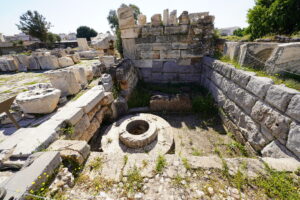
Archaeological Site of Eleusis – Kallichoron well. Source: TimeTravelRome.
The upper circle of the well consists of four connected blocks, and the lower circle of eight blocks each connected by metal clamps. The well is separated from the Roman Court by a low wall constructed in the blue-grey Eleusinian stone in the 5th century. Two doorways gave access to the well enclosure. When the court was paved in the Roman period, the lower step into the well area was cut away to ensure it did not impose upon the sacred enclosure of the Kallichoron Well.
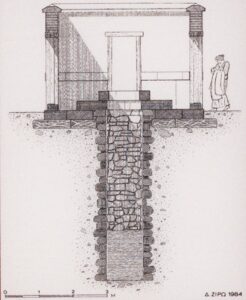
Reconstruction of he Kallichoron well according to D. Giraud. Source: TimeTravelRome.
The Kallichoron Well remains well preserved. Visitors can see the ancient well-head and the surrounding wall in Eleusinian stone. The ground level of the well-head is 1.35 meters lower than that of the Roman Court as it was not re-paved over successive periods as happened with the courtyard.
Sacred Way
The nineteen kilometer long road from Athens to Eleusis was referred to as the Hiera Odos, or the Sacred Way. From Eleusis, the road connected Athens to the Peloponnese. The road was on average 5 meters wide, and paved with small stones with upright blocks forming an edge along each side. In the later Roman period, the Sacred Way was paved in marble and stone slabs. The priests of Temple of Demeter and Persephone at Eleusis were responsible for its maintenance. During the Eleusinian Mysteries, a procession began on the 19th day of Boedromion at the Sacred Gate of the Athenian cemetery (the Kerameikos). Close to Athens, the Sacred Way was lined with tombs and monuments. Further along the ancient path, many sanctuaries lined the road, such as the temple of Aphrodite at Dafni. As the procession crossed the river just east of the entrance to the Sanctuary, each initiate would tie a saffron ribbon around their left foot and right hand, and drink a special sacramental potion (the kykeon) before the final leg of their journey.
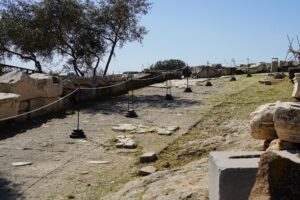
Archaeological Site of Eleusis – Sacred way. Source: TimeTravelRome.
After his initiation into the Mysteries in AD 125, Roman Emperor Hadrian erected the Bridge of Eleusinian Kifissos to aid pilgrims crossing the river. The procession would enter the Sanctuary at Eleusis to gather at the Sacred Court.
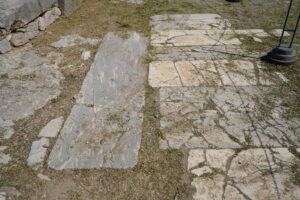
Archaeological Site of Eleusis – Marble slabs of the Sacred way. Source: TimeTravelRome.
The modern highway of the Iera Odos between Elefsina and Athens follows the ancient path of the Sacred Way. The path of the ancient procession once the pilgrims entered the Sanctuary is referred to as the Processional Way and is the path following by visitors today. Many of the artefacts uncovered from along the Sacred Way are displayed in the Archaeological Museum of Eleusis and the Acropolis Museum in Athens.
Eschara
The Roman-era Eschara remains well preserved. Eschara is an altar dated to roman times but excavations have revealed remains dating to the 8th century BC. This altar was constructed as a brick-lined pit within an enclosing wall. Sacrifices to the chthonic deities were burned within the pit. Notches visible around the edge of the altar were used to support an iron grille used for burning meat offerings. The fire was supplied with air through a system of six channels from top to bottom on the lateral walls.
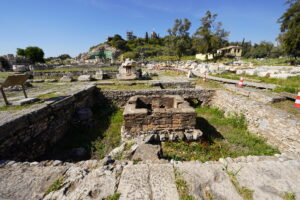
Ground altar Eschara or Grate in Eleusis. Source: TimeTravelRome.
Ploutonion
The Ploutonion was originally a natural cavern that was considered to be the entrance to Hades through which Pluto carried Persephone each autumn, and was then used by Persephone to ascend to the earth each spring. The cavern was the first sacred site visible to initiates as they entered the Sanctuary gate via the North Pylon (and later Lesser Propylaea). During the Peisistratean period, a small temple shrine was constructed within the cave.
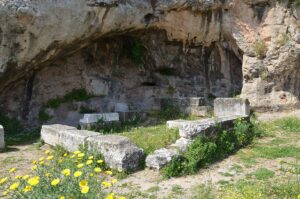
The Ploutonion. By Carole Raddato – Plutonion, Eleusis, CC BY-SA 2.0.
The cavern itself consists of two large chambers, and would likely have been used as part of the cult performances during the Eleusinian Mysteries. The upper portion of the cavern chambers would have been visible to initiates standing on the Sacred Way slightly below the level of the triangular platform. An elliptical opening in the side wall of the smaller, northern chamber gave access to a rock-cut stairway on the outside of the cave. This opening would have allowed someone to enter the cave and then appear on the other side of the Ploutonion. This suggests that it could have been used to enact Persephone’s decent into the underworld and ascent to Eleusis.
Siroi
Siroi were Magazines into which were collected the “aparchai”, the first fruits of the year’s harvest, at a ratio of at least of 1/200 for weat and 1/600 for barley, which all the cities had to offer to Goddess Demeter, as a kind of tax. The delivery of “aparchai” was necessary before the Mysteries were performed in Autumn.
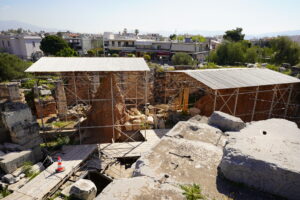
Archaeological Site of Eleusis – Siroi – Magazines where first fruits of the year were stored. Source: TimeTravelRome.
Lykourgian Wall
The Lykourgian Wall and its South Gate were built as fortifications for the Sanctuary between 370 and 360 BC. Although attributed to Lykourgos, they were constructed well before his term in office which began in 337 BC. The Lykourgian Wall extended southward from the line of the earlier Peisistratean wall. The lower section of the walls were built of rectangular cut blue-gray Eleusinian stone in regular courses. The faces are roughly worked although the sides are precisely cut with tight joins. In some areas, the wall also acted as a retaining wall and was up to 4 meters thick. Circular towers with a diameter of around 9 to 10 meters were spaced along the length of the wall. Along the western perimeter of the Lykourgian Wall, a single square tower gave access to the South Gate. While all initiates accessed the Sanctuary from the main, northern entrance, the road from the harbour led to the South Gate.
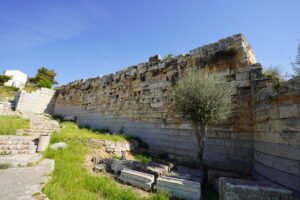
Lykourgian Wall an the South Gate. Source: TimeTravelRome.
The entire Lykourgian Wall was built with exquisite craftsmanship and it remains standing today. The full southern perimeter is visible including the circular towers and the entrance to the Sanctuary at the South Gate. Along the eastern perimeter, the wall is partially visible behind the Roman Cisterns. The different stone materials used in its construction are clearly visible. Several large fragments of inscribed architrave are displayed along the wall including one near the South Gate which reads, ‘Eleusinian Games’.
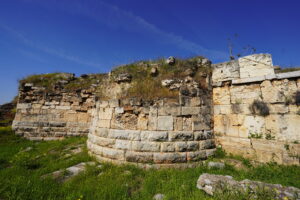
Circular tower and the Wall. Source: TimeTravelRome.
Bouleuterion
The Hellenistic Bouleuterion was among the most important buildings in the sanctuary during the 3rd century BC. Located just inside the southern boundary of the slightly earlier peribolos wall, an inscription reveals that it was built to function as the headquarters for the council of Eleusis.
During the Roman period, the Bouleuterion was modified. The entire length of the building was converted into a stoa. A colonnade extended the full 34 meter length of the original council chamber with an inner and outer row of columns. Partial remains of columns from this area suggest they were of white marble with Ionic capitals. The semi-circular central room was later converted into an Odeion built of grey marble. At the northeastern corner of the Bouleuterion was a pedestal with an attached water basin. A medieval structure was built over the Bouleuterion destroying all but the foundations and lower walls.
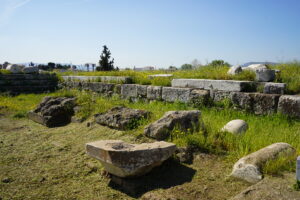
Archaeological Site of Eleusis – Bouleuterion.
The rectangular foundations of the Bouleuterion are visible, in particular the semi-circular steps of the Roman-era odeion. The stepped pedestal, inscribed stelai, column fragments, and scattered architectural elements from the Roman period remain throughout the area.
Eleusis in Roman Times
- Roman Court
Pilgrims on the journey along the Sacred Way from Athens would gather at the Sacred Court. In Roman times the court was paved in marble and is referred to today as the Roman Court. Situated on the northern side of the Sanctuary, the courtyard area measured 65 x 40 meters and was lavishly decorated and monumentalized during the Roman period. From its earliest days, the courtyard contained the Eschara or ground-altar dedicated to Persephone. This altar was constructed as a brick-lined pit within an enclosing wall. Sacrifices to the chthonic deities were burned within the pit, and excavations have revealed remains dating to the 6th century BC.
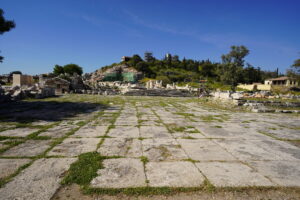
Roman Court of Eleusis. Source: TimeTravelRome.
Construction of the Roman Courtyard was begun under Hadrian and later completed by Marcus Aurelius. The Romans monumentalized the courtyard with the construction of two triumphal arches, an elaborate fountain-house, a temple, an exedra for dignitaries overseeing the procession, and a podium displaying statues. The statues on display included several dedicated to the family of Antoninus Pius, which were arranged in the court near the triumphal arch.
- Greater Propylaea
An inner and outer gate existed at the northern entrance to the Sanctuary from the earliest date of construction. Under Kimon in the 5th century, the gate was elaborated with the construction of the North Pylon, marble pilasters, and a 2-winged wooden door measuring 3 metres in width. During the Roman era, around AD 180, the Sanctuary entrance was vastly monumentalised with the construction of the Greater Propylaea (or gateway) which stood 16 metres high. Part of the dedicatory inscription over the gate and the carved bust of the Roman emperor who oversaw its construction have survived, however both are badly damaged. The carved bust is generally interpreted as depicting Marcus Aurelius, although it may instead show either Hadrian or Antoninus Pius.
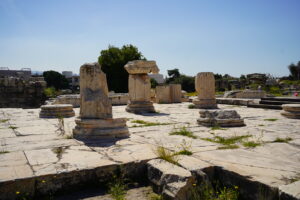
Sanctuary of Eleusis – the Greater Propylaea. Source: TimeTravelRome.
The monumental gateway consists of a northern exterior portico facing the Roman Court. Six steps lead to the porch which is 1.7 metres above the level of the courtyard. The portico was 15.2 metres deep with a facing row of Doric columns and two rows each of three Ionic columns along its depth to divide the entrance into three aisles. The huge facing Doric columns were 8.8 metres high with a diameter of 1.6 meters.
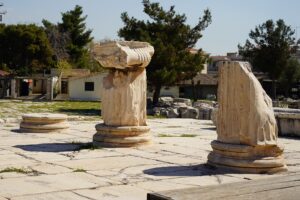
Sanctuary of Eleusis – the Greater Propylaea. Source: TimeTravelRome.
The colonnade supported an entablature with a simple architrave, and decorative frieze of alternating triglyphs and metopes, and an overall triangular pediment. The bust of the Roman Emperor within a carved shield was originally mounted on the pediment. A separate door on one side gave access to the sacred area of the Kallichoron Well.
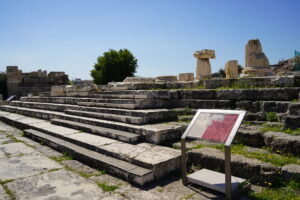
Sanctuary of Eleusis – the Greater Propylaea. Source: TimeTravelRome.
The lower portion of the Greater Propylaea itself is well preserved, although no columns remain standing to their full height. Visitors can walk up the outer stairway and enter the sanctuary through the gateway as the ancient pilgrims did in the past. The pedestal bases of the inner rows of Ionic columns remain in-situ and the marble flooring shows wear along the aisles leading through each of the passageways. Deep grooves in the marble remain from the movement of the doors.
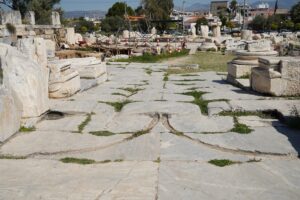
Sanctuary of Euleusis – the Greater Propylaea. Traces from the movement of the doors. Source: TimeTravelRome.
Visitors can also see the many inscribed quadrisected circles and squares that have been drawn onto the steps of the Propylaea – these are the remains of ancient gaming boards that are often found within Roman baths and religious sanctuaries, although their purpose is unclear.
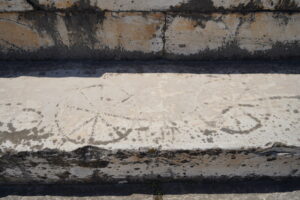
Sanctuary of Eleusis – the Greater Propylaea. Board games on marches. Source: TimeTravelRome.
- Triumphal Arches
Shortly after AD 129, two triumphal arches were built to mark the south-east and south-western entrances to the Roman Court. Pilgrims entering the Sanctuary from Megara would enter through the Western Arch, and those from the harbour would enter via the Eastern Arch. Made of Pentelic marble, the two-storey arches were made to resemble the triumphal arch of Hadrian in Athens. They were constructed under Antoninus Pius or Marcus Aurelius. Each arch was made with a single arched gateway spanning 4.8 meters.
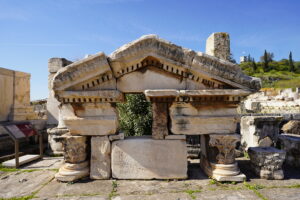
Remains of the East Triumphal Arch.
The facades were decorated with Corinthian pilasters. Between the pilasters on both faces stood a Corinthian column whose lower base was decorated with carved cross-torches (the symbol of the Goddesses). The top of the arch was inscribed with the phrase, “All the Greeks to the Goddesses and the Emperor”. Above the inscription level was an additional attic pediment made to resemble an aedicular shrine. It was built with a row of four Corinthian columns.
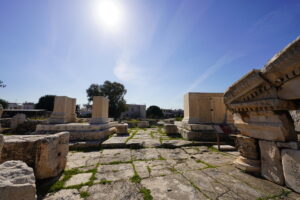
Place of the East Triumphal Arch. Source: TimeTravelRome.
The southeastern triumphal arch is the better preserved of the two arches with reconstruction work showing the arrangement of the entranceway to the Sanctuary. While the columns are no longer standing visitors can see the remains of the elaborate Corinthian capitals. The ornate pediment has also been partially reconstructed. The inscription is displayed alongside the remains of the arch.
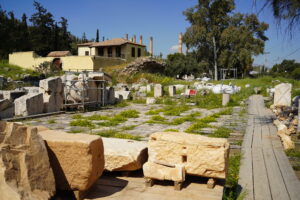
Location of the West Triumphal Arch. Source: TimeTravelRome
- Fountainhouse
During the Hadrianic monumentalization of the northern entrance court to the Sanctuary, a fountainhouse was built along the south-eastern wall of the Roman Court. At the same time cisterns and water drainage channels were constructed under the paved courtyard. The fountainhouse was built in Roman concrete and lined with marble. Excavators found a fragmentary inscription nearby which was likely mounted alongside the fountain. It recorded Emperor Hadrian’s dedication to the goddesses by bringing water to the sanctuary.
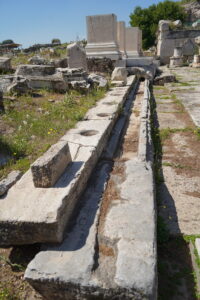
Archaeological Site of Eleusis – Fountain House. Source: TimeTravelRome.
The remains of the fountainhouse are visible on the eastern edge of the courtyard alongside the remains of the triumphal arch. The long basin remains in-situ, and the marble-lined step above the basin shows the eroded imprints from centuries of flowing water as it fell from the waterspouts. Fallen decorative elements from the fountain entablature remain scattered on the raised area above the courtyard.
- Roman Fountains
During Hadrian’s remodelling of the water supply at Eleusis, he oversaw the construction of several new cisterns, an extensive drainage system, and several fountains. Built against the eastern side of the Periklean peribolos wall of the Sanctuary, alongside the Sacred Way, a large Roman Fountain was constructed around AD 129. The fountain was within arm’s reach of the initiates and pilgrims as they walked along the paved pathway. It was used freely by visitors to refresh themselves during the festival. Water for the fountains came from the large cisterns located near the Greater Propylaea via a series of brick aqueducts. The water then settled within the six long, angular brick cisterns that were built against the side of the wall. It would have appeared as a grand and imposing structure with the full height of the fountain lined in marble and ornamental spouts along its full length. As it fell, the flowing water was collected in the shaped channel in front of the fountain and directed outside of the sanctuary towards the river.
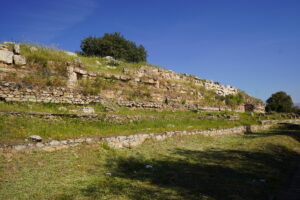
Archaeological Site of Eleusis – roman fountains and cisterns. Source: TimeTravelRome.
The marble façade and decorative elements no longer service, however the series of rectangular holding tanks for the fountain’s water remain. Several of these are partially damaged allowing visitors to see the inner construction and lining of the tanks. The underground aqueduct that connected the fountain to the water cisterns near the Greater Propylaea is exposed in several locations, and visitors can explore the ruins alongside the Sacred Way to trace the path of the Hadrian’s extensive water system.
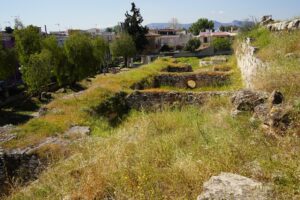
Archaeological Site of Eleusis – roman fountains and cisterns. Source: TimeTravelRome.
- Mithraeum – Mithraion
In the late Roman period, the southern perimeter outside the Sanctuary walls saw an increase in Roman occupation unrelated to the Eleusinian Mysteries. This included the gymnasium, baths, and a building thought to be a temple to Mithras. A number of foreign cults were introduced to Eleusis during the Roman period, including that of Mithras from Persia.
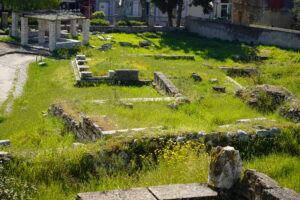
Mithraeum and Gymnasium at Eleusis. Source: TimeTravelRome.
- Temple of Artemis Propylaia
The Temple of Artemis Propylaia (before the gate) and Poseidon Pater is located outside of the main Sanctuary within the Roman Court. It was built in the early 2nd century on top of an 8th century apsidal temple. The earlier temple was likely a Hekataion, or sanctuary of Hecate, who was considered to be the guardian of the crossroads. The apsidal temple was oriented to overlook the approach of the Sacred Way. The later temple of Artemis and Poseidon was built on a raised Roman concrete podium and aligned to overlook the Roman Court. The temple was constructed of Pentelic marble with timber beams supporting a tiled roof. Its pediment was decorated with triglyphs. Two altars stood in front of the temple.
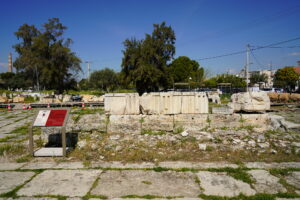
Archaeological Site of Eleusis – Temple of Artemis Propylaia. Source: TimeTravelRome.
The stepped podium remains intact with the Roman-concrete platform showing clearly the arrangement of the temple and altars within the courtyard. A large number of decorative elements are also displayed around the edge of the temple podium.
- Temple of Faustina
This Roman-era temple was initially referred to as Temple L10 by early excavators. It sits atop the hill immediately north of the Telesterion and over 7 meters above ground level. A large area of the rocky spur was levelled for its construction in the later half of the 2nd century AD. Although no dedicatory inscriptions or statues have been found to suggest which divinity the temple honoured, it has been suggested that this Roman temple was built for Faustina the Elder, wife of Antoninus, by Marcus Aurelius, who married her daughter.
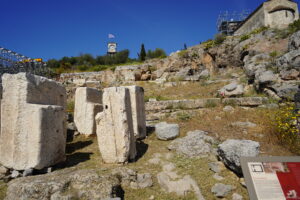
Remains of Sabina Temple at Eleusis. Source: TimeTravelRome.
Very little of the Temple of Faustina remains. The post-Byzantine era Church of Panagitsa was built over the eastern portion of the Roman temple. The foundations of the temple as well as the pavement, threshold, and door emplacements have survived. The marble pavement is best preserved in the south-west corner. At the bottom of the narrow staircase, the square opening for the wooden barricade can still be seen.
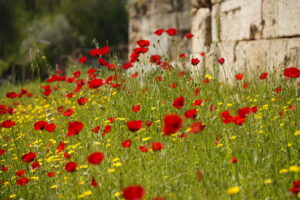
Eleusis in springtime. Source: TimeTravelRome.
Eleusis on TimeTravelRome Mobile App
The site of Eleusis is covered extensively on the Timetravelrome app: a very detailed guide is provided to App users.
